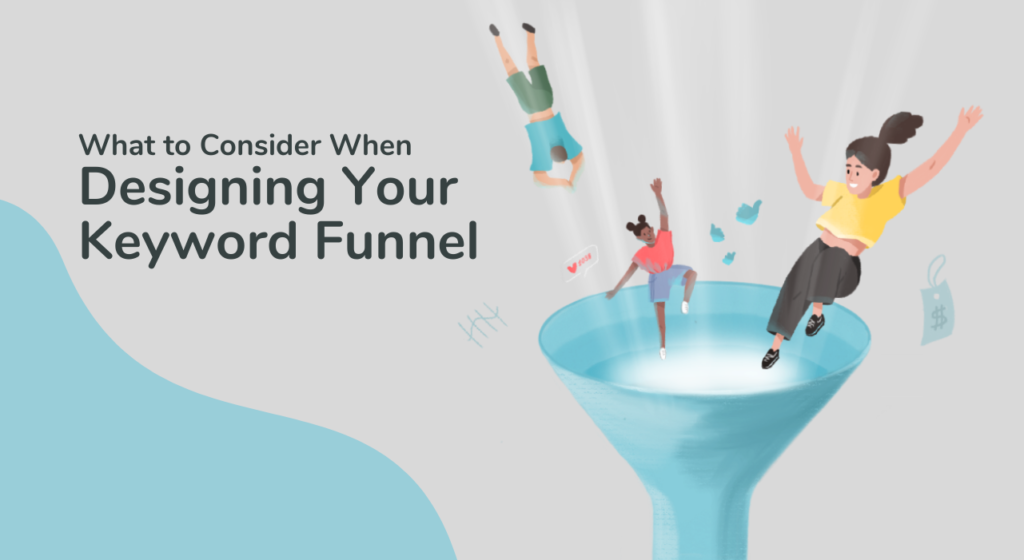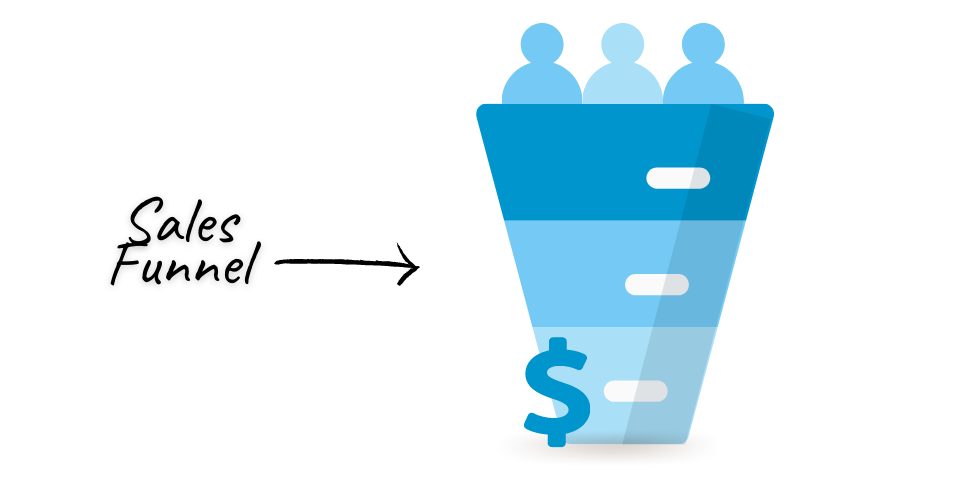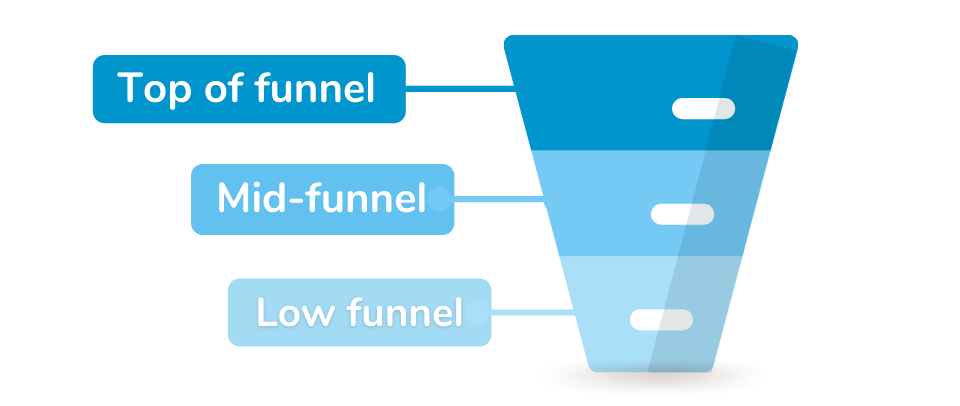How to Design Your Keyword Funnel: SEO and the Buyer’s Journey

You’ve probably heard of the concept of a sales funnel. For most products and services, a person doesn’t necessarily make a purchase on the spot. Instead, they undergo a Buyer’s Journey. They’ll start with research and gathering information, moving step by step toward the point where they’re ready to buy.
When it comes to SEO, you’ll find yourself targeting all kinds of relevant keywords. Some are informational, some reflect imminent purchase intent, and some are in between.
You can segment these keywords based on where they fit into your sales funnel: top, middle, and bottom. This helps you create a clear map that can guide your audience toward buying from you, not your competitors. Clear keyword segmentation is a great way to inform and enrich your SEO and SEM strategy, helping you bring in leads and keep them engaged with your brand every step of the way.

An SEO Strategy Without a Clear Keyword Funnel Structure Is Leaving Money on the Table
Every product or service comes with its own Buyer’s Journey. A given customer goes through an entire process leading up to making a purchase decision. While the breadth, depth, and duration of this process is highly variable, it’s something that’s present for just about everything.
A given consumer will move through an entire process of research, comparison, and exploring their options before they make their final purchase decision. This process, the sales funnel, has an inverse pyramid shape. You’re always going to have more traffic at the top than the bottom, but you’ll want to make sure that as many of these initial early-stage leads as possible are guided downward toward the funnel’s end: the final sale.
A solid SEO strategy doesn’t just select and target keywords haphazardly. Instead, what you want is a clear system of keywords segmentation for your funnel. Different keywords indicate search intent that reflects different points along a person’s journey toward purchasing whatever it is that you’re selling.
The depth and complexity of a sales funnel can vary considerably for different services and products — even for different offerings from the same company. Some products — especially high dollar purchases — have a long sales cycle, requiring you to build extensive consumer trust and carefully nurture leads over time before they’re going to convert.
For example, if you’re selling a $20,000 a year software suite to businesses, your customers aren’t going to make a purchase decision right away, and will carefully consider their options before they’re ready to convert. Even for a company with solid revenue, that’s a sizeable investment they’re not going to make lightly. You need to earn their trust before they’re comfortable converting.
Other products have a very quick sales cycle. If you’re selling scarves for dogs, like a company called Dharf specializes in, you may find that purchase decisions are made quickly. Dharf gets a lot of their purchases from on-the-spot impulse buys, from people who saw their display ads and paid social media placements. A dog scarf isn’t something people generally think of independently, research, and then comparison shop for. You see it, think “wow, that would be so cute on Cupcake!” and click through to pick one up for yourself. Either way, there’s a specific process that consumers move through on their way toward conversion.
You can roughly segment your keyword funnel into three major categories, differentiating low versus high funnel words for a strong SEM strategy:

- Top of funnel keywords: These are things people search for when they’re first looking into their purchase options. In some cases, they already know what kind of project or service they’re looking for, and they’re looking for some more helpful information about it. In other cases, they may know they have a problem they’re trying to solve, but have no idea yet that what you’re selling could be the perfect solution. Targeting these keywords helps make consumers aware that your brand exists, and work to cultivate trust by establishing you as an authority in your niche.
- Mid-funnel keywords: People search for these kinds of queries when they’re getting closer to making a purchase. They’re aware of what they’re looking for, and they’re often in the process of comparing different vendors, looking into price ranges, and otherwise doing research that leads up to a purchase.
- Low funnel keywords: People searching for these kinds of queries are pretty much ready to make a purchase decision. They’re well primed to convert — your goal is to tap into that and make the sale.
When you have a keen sense of how your products’ or services’ sales funnels are structured, and what a typical buyer’s journey is going to look like, you can use this information to strategically target Google searchers at every stage of the process.
You can position any keyword at the top, middle, or bottom of the funnel, tailoring each page’s call to action (CTA) to appeal to exactly what that searcher is looking for. This can range from “Sign up for our newsletter” for a top of funnel keyword, to “Click here to purchase” for bottom-funnel keywords relevant to the point of sale.
If you’re not between keywords that fit at the top, middle, and bottom of the funnel, and you don’t have a cohesive flow between them, you’re probably missing out on a lot of potential sales.

Top of Funnel Keywords: Information, Audience Education, & Brand Awareness
High funnel keywords function to increase awareness of your brand among people in the early stages of the buyer’s journey, as well as cultivating trust and creating a sense that your brand is an authority in your space.
If you want to make sales, consumers need to know that your business exists. Keywords that fit at the top of the funnel reflect the kinds of questions that people ask when they’re trying to solve a particular problem — one for which you’re selling a viable solution.
As a concrete example, we’ll use a hypothetical company that offers guided tours of the Grand Canyon in Arizona.
At the top of the sales funnel for this travel company, we’ll find people who are in the early stages of considering taking a trip to Arizona. They’ve decided it looks like it could be a fun trip, so they’re doing some early research to decide what attractions to visit, when to travel, and how to plan out their trip.
A solid top-of-funnel keyword might be “best travel destinations in Arizona.” Someone searching for this query wants to take a trip soon but isn’t sure yet what tourist attractions in the area are worth visiting. This is a great opportunity to provide them with some information and educational materials, making them aware of your brand and keeping you on their minds in the process.
Bringing In Leads at the Top of Your Funnel
So how do you turn these audiences into viable leads? One approach would be to target the keyword “best travel destinations in Arizona” with an information-rich, well-written landing page about “The 10 Best Travel Destinations in Arizona,” highlighting places where the company offers guided tours. This gives searchers exactly the kind of information they’ve been looking for.
To transform these visitors into leads, getting them onto your email list is an excellent first step. As a CTA on the landing page, you can feature a popup prompting them to sign up for your newsletter. Once they’re on your email list, you’ve opened up an ongoing line of communication with them. You can easily retarget them in the future with deals, discounts, educational materials, and other offerings that keep them engaged with your brand as they move further down through the funnel.

Mid-Funnel Keywords: Moving Toward a Purchase Decision
The middle section of your sales funnel contains people who know about your brand, have a good idea of what they’re looking for, and are moving increasingly closer toward being ready to make a purchase.
Keywords that fit into the middle of a sales funnel tend to revolve around relatively specific questions. The person’s started to get a more solid handle on what they want and need, though they’re not quite ready to buy just yet.
What does a middle funnel keyword look like?
For our hypothetical travel company, a good example of a middle funnel keyword would be “best time of year to visit Grand Canyon.”
Someone who’s typing that into Google has already decided they want to take a trip to Arizona and see the Grand Canyon. At this point, they’re starting to make some concrete travel plans, though they might not quite be ready to book a guided tour just yet.
You could target “best time of year to visit grand canyon” with a landing page about “The Ultimate Guide to Visiting the Grand Canyon.” This page would address common questions people have about visiting it, like the best time of year.
To steer visitors toward conversions, one strategy could be to offer an enticing piece of gated content. Gated content is free to access, but the user has to provide their contact information in order to download it. In this case, an ebook about “Exclusive Grand Canyon Tours,” detailing what the company offers, could be a great way to get mid-funnel visitors onto your email list.

Bottom-Funnel Keywords: Making the Sale
Keywords that fit at the bottom of your sales funnel show clear purchase intent and a high likelihood of conversion. People searching for these kinds of queries are at a point where they’re ready to make a purchase. You want them to make that purchase from you, and not your competitors.
An example of a low funnel keyword for our hypothetical travel company would be “grand canyon touring company.” Someone typing that into Google has already fully decided not only to take a trip to Arizona to see the Grand Canyon but to book a guided tour in order to do so.
A landing page targeting this keyword could be something like “#1 Grand Canyon Tour Company.” This page would have compelling, sales-oriented copy, and would feature a prominent lead gen contact form with a phone number they can call to book their tour.
Pages targeting keywords that fit at the bottom of the funnel should have clear, concise, conversion-oriented messaging. While top and mid-funnel keywords are best targeted with a soft-sell approach, low funnel keywords need persuasive copy that can seal the deal on the spot.
Low funnel keyword clicks have a high potential for resulting in a sale. These are basically your “money pages.” Don’t be afraid to invest in them.
Start Making More Sales with a Clear SEM Keyword Conversion Funnel
If your keyword targeting strategy is all over the board without a structure underlying it, you might be left scratching your head at why your conversion rates have been low.
A clear, well-organized keyword funnel, patterned after the buyer’s journey and sales cycle for your products and services, can go a long way toward helping you capture and retain leads at every step of that process. You’ll strengthen your brand, keep leads engaged, and ultimately, make a lot more sales.
Interested in Updating Your Website?
Contact us to learn more about our design & development services and other methods we use to grow our clients’ brands online.
